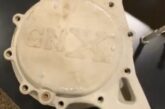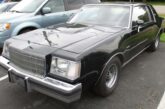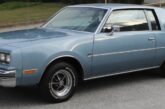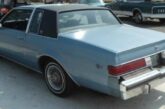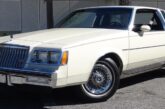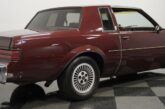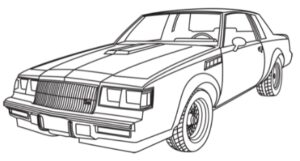Buick began a new corporate performance orientation when it re-acquired its V6 from Jeep, with development work that led to a non-production, turbocharged 3.8 liter (231 cubic inch) V6 Century coupe being selected as the 1976 Indy 500 Pace Car.
In 1981, a naturally aspirated version of the 4.1 Liter V6 Regal Coupe was Buick’s second Indy Pace Car. And on May 29, 1983, a Buick Riviera convertible powered by a sophisticated twin turbocharged 4.1 Liter V6 developing 450 horsepower paced the 67th running of the Indy 500. In the mid 1980’s Buick made serious efforts to compete and win the Indy 500 using its development work on the turbocharged V6 engines.
The Buick Indy engines were acknowledged to be at or above the top of the class at the Speedway as far as raw horsepower was concerned. Its “stock-block” turbocharged V6 Indy cars won the pole position and second spot in qualifying for the Indianapolis 500 in 1985, the first time since mighty Duesenberg in 1931, that an American production based car had won the Indy Pole. Where the Buick turbo V6’s encountered difficulty was in reliability over the long haul of the 500 mile race, something that turbocharged engines of other race car builders have also encountered over the years. It is now very apparent that Buick’s 3.8 Liter turbocharged V6 engine is better suited for relatively short bursts of extreme power production rather than extended periods of sustained high power production. But the Indy efforts made one thing very clear: these Buick high tech V6 engines were highly competitive on the most prestigious racetracks of America. We now examine how this and other corporate racing experiences influenced the design, production and sales of Buick cars.
As early as 1978 Buick began to bring their Indy Turbocharged V6 racing development work into the showroom. The company introduced the 3.8L V6 Turbo in two production cars. One of these was the well-known 1978 Regal Turbo Sport Coupe; the second was the 1978 LeSabre Turbo Sport Coupe. The latter is rarely even mentioned even by Buick Turbo fans and enthusiasts and it is difficult to estimate the production totals for this car. Most of the LeSabre Sport Coupes were produced with the normally aspirated 3.8L V6; separate figures apparently were not kept and the total number of V6 LeSabre Coupes was 29,408. In any case, the 1978 turbocharged V6 LeSabre Sport Coupe was a rare car. The same problem is faced in estimating specific production totals for the Regal Turbo Sport Coupe but the total number of Regals sold was 236,652 and the Turbo Sport Coupe was certainly not a rare model.
In 1979, the total number of Regals produced climbed to 273,365 of which 21, 389 were the V6 Turbo Sport Coupes (or about 8%). Extrapolating backwards, if approximately 8% of Regals produced in 1978 were Turbo Sport Coupes, their production total was about 19,000. The LeSabre Turbo Sport Coupe continued to be available in 1979, and 3,582 were produced. Two other models of Buick became available in 1979 with the V6 Turbo engine, the Century Turbo Coupe and the Riviera S-Type Turbo. The Riviera was an all-new model year in 1979 while the Century was essentially identical to the Century Sport Coupe introduced in 1978 but without the V6 Turbo. The Riviera S-Type was Motor Trend magazine’s Car of the Year and a sales success with 14,300 being produced (of which 2,067 were ordered with the V6 Turbo), but the Century Turbo Coupe became another rare car, with an estimated 1000 – 1200 produced. Thus, altogether in 1979, one could walk into a Buick dealer and order any of four completely different types of cars powered by the 3.8L Turbo V6, the LeSabre Turbo Sport Coupe, Century Turbo Coupe, Regal Turbo Sport Coupe, and Riviera S-Type Turbo, bringing total production of Buick V6 Turbo vehicles to over 27,000 units.
At the turn of the 1980’s, specifically, model years 1980 and 1981, production was down a bit across the board at Buick as inflation gripped the US. Buick dropped availability of the V6 Turbo in the LeSabres, and the production number of the Century Turbo Aerodynamic Coupe was only 1,074. The total Regal production dropped to 214,735, of which the Sport Coupes can be estimated to be about 15,000. The Turbo Riviera became the T-Type instead of S-Type, with both the 4.1L N/A V6 and the 5.7L V8 being optional engines to the TurboV6. However, Turbo Riviera production rose to a healthy 7,217 cars.
In 1981, the general downtrend worsened significantly with prices rising as rapidly as production was dropping. Total Regal production was down to 123,848. While there are no specific production figures on the Regal Turbo Sport Coupes, they probably numbered between 5,000 to 8.000 cars. The Century coupes were dropped altogether, but the Turbo Riviera T-Type production fell to 3,990 (but this was still a strong figure by later Riviera standards).
These two model years (1981 and 1982) marked another period of change for Buick that was influenced by racing of an altogether different brand than Indianapolis, stock car racing sponsored by NASCAR. This story began in 1981 when Buick re-designed the bodies of its popular Regal model. This car dominated NASCAR’S Grand National racing series from 1981 through 1983, winning the Manufacturers Championships in 1981 and 1982, the Grand National Championships in ’81, ’82 and ’83, and the Daytona 500 in ’81, and ’82. As difficult as it is for us to believe today, their successes were based more on the comparatively superior aerodynamics of the Regal body design rather than better engine design.
.


















